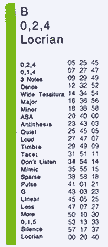
Before Copenhagen I had been improvising with some great players in San Diego. However, I noticed two problems. The first one was semantic. People were calling what they did "non-stylistic improvisation" which seemed ludicrous because it was clear when they would switch from their Boulez bag to their Lutoslawski bag to their Xenakis bag, etc. I think by "non-stylistic" they meant either atonal, stochastic, Euro-modernist, non-vernacular, not a well-known style, etc. Above all, they meant that they were improvising but it was not jazz. The jazz players, particularly the AACM folks, found this ridiculous as they heard these musicians make a lot of the same sounding music as their own. Anyway, I have since adopted George Lewis’ phrase "trans-idiomatic improvisation" which suggests that many idioms, including vernacular ones, are available. In my own work, this does not necessitate that a given piece or even concert is in more than one idiom, although often it is.
The second problem had to do with form. I started to hear the same forms recycled over and over and it became nauseating. There was the "begin quiet, build up to a climax, end quiet" form; there was the "begin with a huge, screaming gesture" form; and so on. Surprisingly, I was hearing only about a half-dozen forms and, for me, this constituted a boring trope.
 When I started a group in Copenhagen with Danish musicians I introduced my improvisation piece S-tog which is based on the city’s subway system, its map and timetables. The piece can be played by any number of players, with any instrumentation, or in any medium. I renamed the subway stations to fairly abstract musical provocations (high, slow, more, don’t listen, etc.). Players synchronize stopwatches and take a trip, acknowledging each provocation at the exact time as indicated in the schedule. Like the citizens of Copenhagen, the players can take the same trip or different ones, of the same or different durations, starting at the same time or not.
When I started a group in Copenhagen with Danish musicians I introduced my improvisation piece S-tog which is based on the city’s subway system, its map and timetables. The piece can be played by any number of players, with any instrumentation, or in any medium. I renamed the subway stations to fairly abstract musical provocations (high, slow, more, don’t listen, etc.). Players synchronize stopwatches and take a trip, acknowledging each provocation at the exact time as indicated in the schedule. Like the citizens of Copenhagen, the players can take the same trip or different ones, of the same or different durations, starting at the same time or not.Even with the rigid timetable S-tog is still a free improvisation. Players can interpret provocations in any manner and choose to consciously ignore them. But by mapping their improvisation onto a formal temporal scheme, a wrench gets thrown into the worn-out collection of forms. New forms seem to emerge with unpredictable discourses. This always produces something really interesting and worthwhile. Usually it produces something regrettable too. At its core, S-tog is more a process of musical exploration than it is a piece of music.
 I have adapted this piece for a number of different contexts, including a 1993 90-minute solo performance with the Merce Cunningham Dance Company. In 1995 I went to Tokyo to arrange a theatrical version for the group MANUFACTURE. In this latter performance players moved on and off stage in accordance with the score, and the lighting design was dynamic, itself an interpretation of the score. Particularly rewarding was the S-tog Trio, a group I formed in San Diego which, for one year, exclusively explored this piece in regular rehearsals and performances.
I have adapted this piece for a number of different contexts, including a 1993 90-minute solo performance with the Merce Cunningham Dance Company. In 1995 I went to Tokyo to arrange a theatrical version for the group MANUFACTURE. In this latter performance players moved on and off stage in accordance with the score, and the lighting design was dynamic, itself an interpretation of the score. Particularly rewarding was the S-tog Trio, a group I formed in San Diego which, for one year, exclusively explored this piece in regular rehearsals and performances.